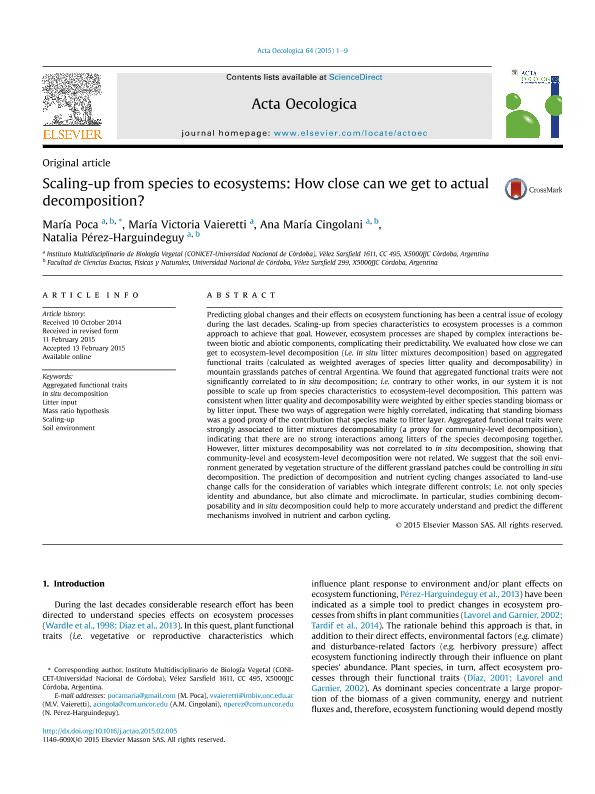Mostrar el registro sencillo del ítem
dc.contributor.author
Poca, María

dc.contributor.author
Vaieretti, Maria Victoria

dc.contributor.author
Cingolani, Ana María

dc.contributor.author
Pérez Harguindeguy, Natalia

dc.date.available
2017-08-17T14:16:22Z
dc.date.issued
2015-01
dc.identifier.citation
Poca, María; Vaieretti, Maria Victoria; Cingolani, Ana María; Pérez Harguindeguy, Natalia; Scaling-up from species to ecosystems: how close can we get to actual decomposition?; Gauthier-villars/editions Elsevier; Acta Oecologica; 64; 1-2015; 1-9
dc.identifier.issn
1146-609X
dc.identifier.uri
http://hdl.handle.net/11336/22554
dc.description.abstract
Predicting global changes and their effects on ecosystem functioning has been a central issue of ecology during the last decades. Scaling-up from species characteristics to ecosystem processes is a common approach to achieve that goal. However, ecosystem processes are shaped by complex interactions between biotic and abiotic components, complicating their predictability. We evaluated how close we can get to ecosystem-level decomposition (i.e. in situ litter mixtures decomposition) based on aggregated functional traits (calculated as weighted averages of species litter quality and decomposability) in mountain grasslands patches of central Argentina. We found that aggregated functional traits were not significantly correlated to in situ decomposition; i.e. contrary to other works, in our system it is not possible to scale up from species characteristics to ecosystem-level decomposition. This pattern was consistent when litter quality and decomposability were weighted by either species standing biomass or by litter input. These two ways of aggregation were highly correlated, indicating that standing biomass was a good proxy of the contribution that species make to litter layer. Aggregated functional traits were strongly associated to litter mixtures decomposability (a proxy for community-level decomposition), indicating that there are no strong interactions among litters of the species decomposing together. However, litter mixtures decomposability was not correlated to in situ decomposition, showing that community-level and ecosystem-level decomposition were not related. We suggest that the soil environment generated by vegetation structure of the different grassland patches could be controlling in situ decomposition. The prediction of decomposition and nutrient cycling changes associated to land-use change calls for the consideration of variables which integrate different controls; i.e. not only species identity and abundance, but also climate and microclimate. In particular, studies combining decomposability and in situ decomposition could help to more accurately understand and predict the different mechanisms involved in nutrient and carbon cycling.
dc.format
application/pdf
dc.language.iso
eng
dc.publisher
Gauthier-villars/editions Elsevier

dc.rights
info:eu-repo/semantics/openAccess
dc.rights.uri
https://creativecommons.org/licenses/by-nc-sa/2.5/ar/
dc.subject
Aggregated Functional Traits
dc.subject
In Situ Decomposition
dc.subject
Litter Input
dc.subject
Mass Ratio Hypothesis
dc.subject
Scaling-Up
dc.subject
Soil Environment
dc.subject.classification
Bioquímica y Biología Molecular

dc.subject.classification
Ciencias Biológicas

dc.subject.classification
CIENCIAS NATURALES Y EXACTAS

dc.title
Scaling-up from species to ecosystems: how close can we get to actual decomposition?
dc.type
info:eu-repo/semantics/article
dc.type
info:ar-repo/semantics/artículo
dc.type
info:eu-repo/semantics/publishedVersion
dc.date.updated
2017-08-08T14:29:07Z
dc.journal.volume
64
dc.journal.pagination
1-9
dc.journal.pais
Francia

dc.journal.ciudad
Paris
dc.description.fil
Fil: Poca, María. Consejo Nacional de Investigaciones Científicas y Técnicas. Centro Científico Tecnológico Conicet - Córdoba. Instituto Multidisciplinario de Biología Vegetal. Universidad Nacional de Córdoba. Facultad de Ciencias Exactas Físicas y Naturales. Instituto Multidisciplinario de Biología Vegetal; Argentina
dc.description.fil
Fil: Vaieretti, Maria Victoria. Consejo Nacional de Investigaciones Científicas y Técnicas. Centro Científico Tecnológico Conicet - Córdoba. Instituto Multidisciplinario de Biología Vegetal. Universidad Nacional de Córdoba. Facultad de Ciencias Exactas Físicas y Naturales. Instituto Multidisciplinario de Biología Vegetal; Argentina
dc.description.fil
Fil: Cingolani, Ana María. Consejo Nacional de Investigaciones Científicas y Técnicas. Centro Científico Tecnológico Conicet - Córdoba. Instituto Multidisciplinario de Biología Vegetal. Universidad Nacional de Córdoba. Facultad de Ciencias Exactas Físicas y Naturales. Instituto Multidisciplinario de Biología Vegetal; Argentina
dc.description.fil
Fil: Pérez Harguindeguy, Natalia. Consejo Nacional de Investigaciones Científicas y Técnicas. Centro Científico Tecnológico Conicet - Córdoba. Instituto Multidisciplinario de Biología Vegetal. Universidad Nacional de Córdoba. Facultad de Ciencias Exactas Físicas y Naturales. Instituto Multidisciplinario de Biología Vegetal; Argentina
dc.journal.title
Acta Oecologica

dc.relation.alternativeid
info:eu-repo/semantics/altIdentifier/url/http://www.sciencedirect.com/science/article/pii/S1146609X15000211
dc.relation.alternativeid
info:eu-repo/semantics/altIdentifier/doi/http://dx.doi.org/10.1016/j.actao.2015.02.005
Archivos asociados
